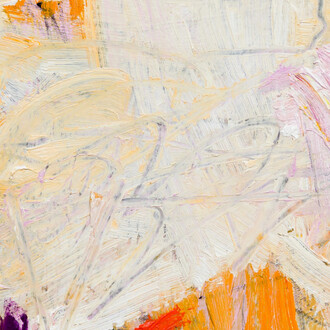2014 marks the ‘Year of the Homecoming’ in Scotland, a year-long programme of events celebrating the country’s food, drink, natural resources, ancestral heritage and culture. As the world looks to Scotland for major sporting events, including the XXth Commonwealth Games in July and the 40th Ryder Cup at Gleneagles in September, the country’s commitment to art and creativity will also come under the spotlight. Scotland’s public museums are showcasing major exhibitions celebrating native artists, such as GENERATION: 25 years of Contemporary Art in Scotland at the Scottish National Gallery of Modern Art.
Flowers Gallery is delighted to join the celebrations with an exhibition of figurative paintings by nine prominent Scottish artists at our Cork Street space 6 – 30 August, 2014. The exhibitors include the famous ‘New Glasgow Boys’ Peter Howson, Ken Currie, Steven Campbell, Stephen Conroy and Adrian Wiszniewski, who all studied at Glasgow School of Art in the 1980’s. The group spear-headed a revival of interest in ambitious figure painting, and their international success has contributed significantly to the cultural renaissance of Glasgow as a city in recent decades. Also featured in the exhibition is the work of John Bellany, Jock McFadyen, Eduardo Paolozzi and Alison Watt, providing viewers with a unique overview of the strong tradition of figurative work by Scottish artists.
Peter Howson has established a formidable reputation as one of his generation’s leading figurative painters. Many of his works take inspiration from the streets of Glasgow, where he was raised, and he is renowned for having a penetrating insight into the human condition. Howson has exhibited in major shows around the world including the Museum of Modern Art, New York, and Scottish National Portrait Gallery, Edinburgh, and was awarded an OBE in 2009.
Despite an early interest in painting industrial Glasgow, Ken Currie became deeply concerned with political and humanitarian events, painting decaying and damaged bodies as a response to what he felt was a sickness of contemporary society. The artist’s recent works remain focused on the human condition, and his paintings hang in the collections of the Scottish National Gallery of Modern Art, Edinburgh, the New York Public Library, New York, and many more.
Born in Paisley, Scotland, Jock McFadyen has undertaken several important residencies and commissions throughout his career, including being appointed Artist in Residence at the National Gallery, London in 1981, and documenting the dismantling of the Berlin Wall in 1992 for the Imperial War Museum, London. McFadyen has remained deeply interested in the history of painting, citing Lowry and Sickert as having had a major influence on his practice. Although his earlier work included schematic narrative paintings, by the early 1990’s figures fell away from the artist’s work and he became consumed by urban landscape.
Alison Watt, also a student at the Glasgow School of Art in the 1980’s, gained early acclaim for her figure painting, often female nudes captured in dryly painted light-filled interiors. In the late 1990’s, she began to introduce fabric alongside these figures, alluding to the influence of 19th century painter Ingres on her work. By early 2000, several of her paintings portrayed swathes of fabric alone, which although more abstract, still suggested a human presence. Watt was selected to be an Associate Artist at the National Gallery, London from 2006-2008, and is currently exhibiting a major retrospective at Perth Museum and Art Gallery.
Eduardo Paolozzi was born in Leith, Scotland to Italian parents and studied at Edinburgh College of Art in the 1940’s. He has established a position as one of Britain’s leading sculptors and is acknowledged as a creator of British Pop Art. The artist’s preoccupation with man and machine allowed him to bring art and science together in his work in a unique way. His sculptures can be found in major public collections around the world, one of his most notable pieces being the bronze Newton after Blake commissioned for the piazza of the British Library in 1995.
Stephen Conroy achieved great success from an early stage in his career, hailed as the ‘boy wonder’ of Scottish painting. He has lived and worked in Scotland for the majority of his life, and his paintings and prints of brooding, anonymous single figures and studies of heads have cemented his reputation as one of the foremost figurative artists working in Europe. He began his studies at Glasgow School of Art just as Steven Campbell was leaving, who he cites as having influenced his choice of figurative subjects.
Steven Campbell discovered art slightly later in life, studying at Glasgow School of Art as a mature student. Upon graduating he was awarded the Fullbright Scholarship, which he used to study at the Pratt Institute, New York. This resulted in several early American exhibitions. The artist was known for combining a strong colour palette with hard linear brushwork, creating paintings with a literary influence. Many of Campbell’s works contain recurring motifs, such as skulls, birds and paisley patterns.
Born and raised in a fishing village near Edinburgh, the work of John Bellany was often influenced by the sea, although it was transformed into a kind of personal mythology. Famed for producing large allegorical compositions featuring hybrid human and animal forms, Bellany painted with explosive, vigorous brushwork in a tormented, expressionist style.
Adrian Wiszniewski is a painter, draughtsman and printmaker producing large-scale figurative works with a tone of reflection or self-parody. Neon colour and economical use of line are key characteristics of the artist’s style, often setting contemplative figures within Arcadian landscapes. His has been awarded several prominent public commissions throughout his career, including the paintings for Liverpool’s Anglican Cathedral.
Flowers Gallery is pleased to offer the opportunity to experience striking works by some of Scotland’s most renowned figurative artists during such a significant year for the country. The collection will reveal interesting new parallels between a group of artists each with a unique approach to a shared subject, and a unique understanding of their shared Scottish heritage.
















